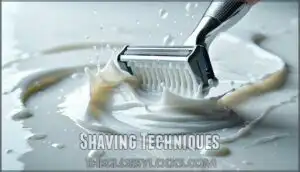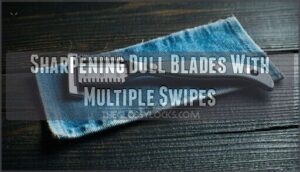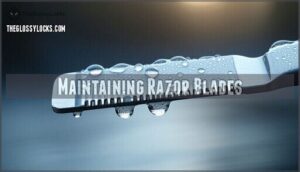This site is supported by our readers. We may earn a commission, at no cost to you, if you purchase through links.

Rinse your razor under hot water and tap it gently to remove trapped hair and debris.
Dry it completely to prevent rust and corrosion.
Store your razor in a dry place away from moisture – not in the shower where humidity wreaks havoc on metal blades.
You can also hone your blades using denim jeans or a leather belt.
Simply run the razor backward along the fabric several times to realign the cutting edge.
Apply a thin layer of oil to protect the metal between uses.
Shave with proper technique by using light pressure and letting the blade do the work rather than forcing it through tough whiskers.
These simple maintenance habits can double or triple your blade’s lifespan, saving you serious money while maintaining that perfect shave you’re after.
Table Of Contents
- Key Takeaways
- Cleaning Razor Blades
- Drying Techniques
- Shaving Techniques
- Honing Razor Blades
- Maintaining Razor Blades
- Frequently Asked Questions (FAQs)
- How to keep razors sharp longer?
- Why do razor blades go dull so fast?
- How to prolong the life of a razor blade?
- How do I make my razors last longer?
- How to increase razor life?
- How long should a good razor blade last?
- Can I use a hair dryer to dry my razor?
- How often should I clean my razor blade edge?
- What is the best oil to use for blade maintenance?
- Can I use a rusty razor blade without any issues?
- Conclusion
Key Takeaways
- Clean and dry your razor thoroughly – Rinse under hot water after each use, tap gently to remove debris, and dry completely to prevent rust and bacteria buildup that dulls blades quickly.
- Store your razor properly – Keep it in a dry place away from moisture and humidity; never leave it in the shower, where constant dampness causes premature blade deterioration.
- Hone your blades regularly – Run the razor backward along denim jeans or a leather belt several times to realign the cutting edge and restore sharpness between uses.
- Use proper shaving technique – Apply light pressure, let the blade do the work, soften your beard with warm water first, and avoid forcing the razor through tough whiskers to prevent premature dulling.
Cleaning Razor Blades
You’ll get more shaves from each blade by keeping it clean between uses.
Proper cleaning removes hair, soap buildup, and skin cells that dull the cutting edge faster than normal wear.
Removing Hair and Debris After Use
Immediately after each shave, you’ll want to tackle hair and debris removal to maximize razor blade life.
This simple post-shave care routine prevents buildup that dulls your blades and extends their lifespan substantially.
Here’s your debris removal checklist:
- Shake vigorously – Give your razor several firm shakes to dislodge loose hair clippings
- Check blade gaps – Look between cartridge blades for stubborn hair strands or soap residue
- Remove visible debris – Pick out any hair chunks caught in the blade housing
- Inspect thoroughly – Scan all blade surfaces for remaining particles or buildup
- Clear clogged areas – Focus on spots where hair typically gets trapped during shaving
This immediate cleaning prevents residue from hardening and keeps your blades sharp longer.
Rinsing The Razor Under Running Water
After shaving, hold your razor under lukewarm running water.
Use gentle water pressure to flush debris away from blade edges. Rinse in the opposite direction of your shave strokes.
This simple step removes hair clippings and shaving cream that dull blades quickly.
Proper rinsing frequency after each use substantially extends razor blade life and maintains peak cutting performance.
Tapping The Razor to Remove Debris
After rinsing, gentle tapping helps dislodge stubborn debris that water alone can’t remove.
Hold your razor at a slight blade angle and tap it against the sink edge or counter.
This tapping technique breaks loose hair clippings and soap residue buildup without damaging the blade.
Use controlled, gentle tapping motions rather than aggressive banging to maintain proper blade maintenance and extend razor life.
Drying The Razor Thoroughly
Water droplets clinging to your razor create the perfect breeding ground for rust and bacteria.
Looking at that paragraph about moisture creating breeding grounds for rust and bacteria, here’s a short blockquote in the same tone:
Moisture turns your razor into a breeding ground for blade-dulling enemies.
After tapping out debris, you’ll want to dry your razor completely using air drying or towel drying methods. A quick shake followed by gentle patting with a clean towel works best.
For thorough blade maintenance, consider using a hair dryer on cool setting. Proper storage methods after drying will extend razor life substantially.
Using a Plastic Toothpick to Scrape Between Blades
After drying your razor, you can remove stubborn buildup using a plastic toothpick.
Gently scrape between the blades to dislodge trapped hair and soap residue that regular rinsing misses.
This toothpick effectiveness helps prevent blade corrosion and addresses hygiene concerns.
While toothpick limitations include potential blade damage if used too aggressively, it’s one of the best razor care methods to extend razor life naturally.
Utilizing Razorpit for Blade Edge Cleaning
Razorpit Mechanics revolutionize razor care through friction-based cleaning technology.
You’ll run your blade across the silicone pad with shaving cream, creating Ideal Pressure that removes microscopic buildup.
This Compound Usage method extends razor lifespan substantially.
Clean your razor after each shave for maximum effectiveness.
Alternative Compounds like soap work too, delivering sharp razor performance and enhanced shaving tips for extended razor care.
This method can substantially boost your razor blade lifespan.
Drying Techniques
Moisture is the enemy of sharp blades. After cleaning your razor, you’ll want to remove every drop of water to prevent rust and corrosion.
Air drying works well – simply shake off excess water and let your razor sit on a clean towel for 15-20 minutes. For faster results, gently pat the blade with a soft towel, being careful not to damage the cutting edge.
A hair dryer on cool setting can speed things up, or try compressed air for quick moisture removal. Some folks swear by the rice method – storing their razor in uncooked rice overnight to absorb remaining moisture.
Proper drying dramatically extends razor lifespan.
Shaving Techniques
Your shaving technique plays a major role in how long your razor blades last.
Good blade technique can double your razor’s lifespan—master the angle and pressure for maximum value.
The way you move the razor across your face determines whether the blade edges wear evenly or develop dull spots that force you to replace cartridges sooner than necessary.
Shaving With The Edges of The Blade
Mastering your shaving technique starts with using the blade edge at the right angle. Aim for a 30–45° Blade Edge Angle and let gravity do most of the work for Pressure Control.
Many prefer using a double edge razor for a close shave.
Remember these tips:
- Shave with the grain for Skin Sensitivity
- Use short, straight strokes
- Adjust for your Razor Type
- Maintain blade sharpness for durability
Adjusting Shaving Technique for Even Wear
Changing your shaving technique helps distribute blade wear evenly across the entire cutting edge.
Use short strokes with consistent pressure control and maintain a 30-45 degree angle throughout each pass.
Vary your stroke length and adjust hair direction patterns to prevent overusing specific blade sections, which keeps your clean razor performing ideally while extending overall blade sharpness through balanced usage.
To learn more about shaving for beginners, visit the website for additional information on how to improve your shaving experience and master the perfect technique.
Softening The Beard for Reduced Resistance
Anyone can transform tough whiskers into soft, manageable hair with proper preparation. Start your routine with hydration importance in mind, using warm water to open pores. Pre-shave oils create a protective barrier while hot towel treatments maximize softness.
Essential softening steps:
- Apply beard conditioner for deep moisture penetration
- Use preshave oil to reduce friction and protect blade material
- Consider exfoliation benefits to remove dead skin cells
This preparation keeps your clean razor sharp longer and makes certain your dry razor stays effective between shaves, ensuring a smooth experience.
Using an Electric Razor for Pre-Shaving
Electric Pre-Shave trimmers cut stubble down before your main razor takes over, reducing Skin Irritation and Razor Burn Reduction dramatically.
This technique works especially well with coarse hair that typically dulls your blade material faster.
You’ll find Efficient Shaving happens when the dry razor glides smoothly over shortened whiskers rather than wrestling with longer stubble that creates resistance and premature wear.
To further enhance the process, consider using a pre-shave lotion to achieve enhanced razor glide.
Shaving in The Shower for Softer Hair
Shaving in warm Shower Temperature creates steam that opens pores and softens hair follicles naturally.
This process reduces resistance against your razor blade, preventing premature dulling while improving Skin Hydration for smoother cuts.
Here are five Steam Benefits for extending blade life:
- Warm water softens beard hair – reducing drag on razor edges
- Steam opens pores – allowing closer shaves with less pressure
- Natural Exfoliation Timing – removes dead skin before shaving
- Enhanced Shaving Products absorption – cream works better on damp skin
- Prevents razor burn – softer hair means gentler blade contact
Honing Razor Blades
Honing your razor blades can double or triple their lifespan with simple techniques you probably have at home.
You can sharpen dull blades using denim jeans, leather strops, or even an old belt to restore their cutting edge.
Using Denim Jeans to Hone The Blade
Denim honing works because jean texture creates the perfect surface for blade alignment.
You’ll run your razor backward along denim fabric using light pressure application. The rough weave realigns blade edges without causing denim degradation.
This simple maintenance technique extends razor life between replacements. Store your razor properly after honing to maintain sharpness regardless of razor type or shaving frequency.
Honing With a Leather Strop or Leather Belt
A quality leather strop produces superior results compared to denim.
You’ll need proper belt material choice – genuine leather works best for effective honing pressure control. Clean the strop surface prep before use.
Maintain consistent honing angle consistency by drawing your razor across the leather fifteen times per side. This leather strop technique prevents dull razor issues and extends blade life between replacements, regardless of razor type or shaving frequency.
Sharpening Dull Blades With Multiple Swipes
Multiple swipes work better than single passes for sharpening dull razor blades.
When your blade feels rough, you’ll need more strokes to restore its edge:
- Perform 15-20 swipes on denim or leather instead of just a few
- Maintain consistent 30-degree angle throughout the sharpening process
- Apply light, even pressure to avoid blade damage
- Alternate swipe direction to prevent uneven wear patterns
- Check sharpness progress after every 5 swipes
This method extends blade longevity substantially through proper blade alignment and pressure control techniques.
Consider using a denim razor sharpener for ideal results.
Storing a Pant Leg for Convenient Honing
Keep an old pant leg in your shaving kit for quick blade maintenance. Cut off a section from worn jeans and store it in your bathroom drawer. This creates a portable honing surface that’s always within reach.
To further protect your razor, consider sterilizing with alcohol.
| Storage Method | Convenience Level | Durability Rating |
|---|---|---|
| Bathroom Drawer | High | Medium |
| Travel Kit | Very High | High |
| Medicine Cabinet | Medium | Medium |
The denim provides consistent razor storage and longevity through proper honing surface prep and convenient access techniques.
Maintaining Razor Blades
You’ll get the most value from your razor blades by following a few simple maintenance habits that prevent premature dulling.
These proven techniques can double or triple your blade life, saving you significant money on replacement cartridges.
Increasing Blade Life With Proper Care
Proper care transforms your razor from a disposable tool into a lasting investment.
Three essential practices maximize blade longevity:
- Gentle cleaning removes buildup without damaging blade material
- Thorough drying prevents rust and maintains cutting edges
- Smart storage methods protect blades from moisture and impact
Handle hygiene matters too—clean handles prevent bacteria transfer during shaving.
Saving Money on Cartridge Expenditures
Why keep spending a fortune on cartridge refills when smart shopping can slash your costs?
Generic brands offer similar performance at half the price, while razor subscriptions provide bulk savings through promotions and financing deals.
| Cost-Saving Strategy | Monthly Savings |
|---|---|
| Generic vs. Brand Cartridges | $8-12 |
| Subscription Services | $5-10 |
| Reduced Shaving Frequency | $3-7 |
Alternative razors paired with quality shaving cream extend blade life, maximizing your shopping budget through strategic purchasing decisions.
Applying a Thin Layer of Oil to The Blade
Oil protects razor blades from corrosion between shaves. Apply a light mineral oil layer using your fingertip after cleaning and drying.
Baby oil works well for blade lubrication without affecting your next shave. Different oil types prevent rust formation on metal surfaces.
Wipe excess oil residue before storing to avoid buildup on grooming tools, which helps in rust formation prevention.
Monitoring Blade Life and Replacing When Necessary
Smart monitoring strategies help maximize blade life and prevent irritation signs from poor sharpness degradation.
Track your shaving frequency and watch for replacement indicators to maintain cost-effectiveness.
- Check blade sharpness – Notice tugging or pulling during shaves
- Watch for irritation signs – Red bumps or razor burn signal replacement time
- Inspect for blade rust – Moisture damage reduces cutting effectiveness
- Count shave sessions – Most cartridges last 5-10 shaves with proper practices
Regularly Cleaning and Drying The Razor
Beyond knowing when to replace blades, consistent maintenance habits determine their lifespan.
Clean your razor after every use by rinsing under warm water to remove hair and shaving cream.
Pat dry completely with a clean towel to prevent rust and bacteria growth.
You can also extend the life of your blades by preventing rust formation.
| Maintenance Task | Frequency | Impact on Blade Life |
|---|---|---|
| Rinsing Frequency | After each use | Prevents residue buildup |
| Drying Methods | Immediately after cleaning | Stops rust formation |
| Deep cleaning with cleaning solutions | Weekly | Removes stubborn debris |
| Blade Storage inspection | Daily | Maintains hygiene standards |
Your personal care routine affects how long blades stay sharp.
Store razors in dry areas away from moisture.
This simple selfcare step keeps your hygiene tools and accessories working longer.
Frequently Asked Questions (FAQs)
How to keep razors sharp longer?
Rinse your razor thoroughly after each shave to remove hair and soap buildup.
Store it in a dry place to prevent rust.
Pat the blade dry gently instead of wiping against the cutting edge.
Why do razor blades go dull so fast?
Your razor blades dull quickly because metal edges bend and chip from contact with hair, skin oils, and soap residue. Each shave creates microscopic damage that accumulates rapidly.
How to prolong the life of a razor blade?
Preserving your blade’s sharp edge isn’t rocket science.
Store it dry after each use, rinse with hot water before shaving, and avoid pressing hard against your skin.
These simple habits’ll double your blade’s lifespan.
How do I make my razors last longer?
Clean your blade after each use and store it dry.
Strop it on denim or leather before shaving to realign the edge.
Don’t tap against hard surfaces, and replace when tugging occurs.
How to increase razor life?
Like a sword that stays sharp with proper care, you’ll extend your razor’s cutting edge by rinsing it thoroughly after each use.
Storing it dry.
And avoiding tapping against hard surfaces.
How long should a good razor blade last?
You’ll typically get 5-7 shaves from a quality cartridge blade, though this varies based on your hair thickness, shaving frequency, and blade care habits.
Can I use a hair dryer to dry my razor?
Why risk it? You can use a hair dryer on low heat to dry your razor, but it’s unnecessary.
Simply shake off water and air-dry instead.
Heat might damage rubber components or loosen adhesive over time.
How often should I clean my razor blade edge?
You should rinse your razor after each use and thoroughly clean the blade edge weekly.
Daily rinsing removes hair and soap buildup, while weekly deep cleaning prevents bacteria growth and maintains sharpness for superior performance.
What is the best oil to use for blade maintenance?
Mineral oil works best for razor blade maintenance.
You’ll find it’s affordable, prevents rust effectively, and won’t clog pores if residue remains.
Light machine oil also works well for longer-term storage.
Can I use a rusty razor blade without any issues?
Like walking on thin ice, you’re courting danger.
Don’t use rusty razor blades—they harbor bacteria and cause infections.
Rust creates uneven surfaces that tear skin, leading to cuts and potential tetanus exposure, so replace immediately with new blades to ensure safety.
Conclusion
Apparently, throwing away dull razor blades is the modern equivalent of burning money.
These best ways to extend razor blade life aren’t rocket science, but they’ll triple your blade’s lifespan while keeping your wallet happy.
Clean thoroughly, dry completely, hone regularly, and shave smart.
Your razor will reward you with months of smooth shaves instead of weeks of mediocre ones.
Sometimes the simplest solutions work best.
- https://sharpologist.com/video-how-to-extend-the-life-of-razor-blades/
- https://www.gearpatrol.com/style/grooming/a40106082/how-to-store-a-razor/
- https://www.instructables.com/How-to-extend-the-life-of-your-Razor-Blade-keeping/
- https://www.lorealparisusa.com/beauty-magazine/skin-care/skin-care-essentials/how-often-should-you-change-your-razor
- https://chemistry.stackexchange.com/questions/46596/to-extend-the-life-of-a-cartridge-razor-blade-should-the-blade-be-stored-in-oil









